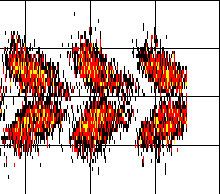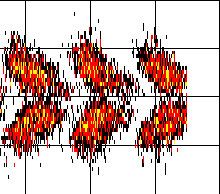![]()
![]()
![]()
Use LEFT and RIGHT arrow keys to navigate between flashcards;
Use UP and DOWN arrow keys to flip the card;
H to show hint;
A reads text to speech;
58 Cards in this Set
- Front
- Back
|
innermost layer
|
CORE
|
|
|
outermost layer
|
CORONA
|
|
|
apparent surface
|
PHOTOSPHERE
|
|
|
layer experiencing nuclear fusion
|
CORE
|
|
|
layer heated by electromagnetic waves given off by core
|
RADIATION ZONE
|
|
|
layer where heated material rises and cool material falls
|
CONVECTION ZONE
|
|
|
large amount of ejected gas
|
SOLAR PROMINENCE
|
|
|
large explosion on surface
|
SOLAR FLARE
|
|
|
cooler areas of the surface
|
SUNSPOT
|
|
|
releases energy over a very short period
|
SOLAR FLARE
|
|
|
releases energy over a longer period
|
SOLAR PROMINENCE
|
|
|
the "atmosphere"
|
CHROMOSPHERE, TRANSITION ZONE and CORONA
|
|
|
layer appearing granulated
|
CONVECTION ZONE
|
|
|
has storms that emit spicules
|
CHROMOSPHERE
|
|
|
difficult to see do to brightness of photosphere
|
CHROMOSPHERE
|
|
|
prominences and sunspot locations are closely related to...
|
MAGNETIC FIELD LINES
|
|
|
electrically charged gas streaming from the Sun
|
SOLAR WIND
|
|
|
cause of auroras
|
SOLAR WIND INTERACTING WITH EARTH'S ATMOSPHERE AND MAGNETIC FIELD
|
|
|
another name for auroras
|
NORTHERN/SOUTHERN LIGHTS
|
|
|
densest layer
|
CORE
|
|
|
least dense layer
|
CORONA
|
|
|
formation of new elements
|
NUCLEOSYNTHESIS
|
|
|
element formed on the Sun
|
HELIUM
|
|
|
state of matter of stars
|
PLASMA
|
|
|
forces currently preventing solar expansion or collapse
|
GRAVITY (INWARD) and HEAT/PRESSURE (OUTWARD)
|
|
|
current energy source for the Sun
|
NUCLEAR FUSION (of H to He)
|
|
|
symbol for energy
|
E
|
|
|
symbol for mass
|
m
|
|
|
symbol for speed of light
|
c
|
|
|
states that a small amount of mass is equivalent to large amounts of energy
|
E=mc2
|
|
|
requirement for nuclei to fuse rather than repel
|
EXTREMELY HIGH TEMPERATURES
|
|
|
the layer we see on a normal day
|
PHOTOSPHERE
|
|
|
hottest layer
|
CORE
|
|
|
coolest layer
|
CHROMOSPHERE
|
|
|
rotational period of poles vs. equator
|
FASTER AT POLES
|
|
|
zone marking temperature increase in atmosphere
|
TRANSITION ZONE
|
|
|
average solar temperature
|
5800K
|
|
|
unit of temperature
|
KELVIN (K)
|
|
|
length of Sun cycle
|
11 YEARS (22 YEARS)
|
|
|
period of few sunspots
|
SOLAR MINIMUM
|
|
|
period of many sunspots
|
SOLAR MAXIMUM
|
|
|
two major elements on the Sun
|
HYDROGEN and HELIUM
|
|
|
thin, dark (cool) spikelike regions
|
SPICULES
|
|
|
layer on which sunspots and prominences occur
|
PHOTOSPHERE
|
|
|
location of solar flares
|
CHROMOSPHERE
|
|
|
BUTTERFLY GRAPH
|

Name the graph
|
|
|
SUNSPOT CYCLE; MAP OF SUNSPOTS
|

What does this graph show?
|
|
|
hydrogen-1 is equivalent to a...
|
PROTON
|
|
|
hydrogen-2 is called
|
DEUTERON
|
|
|
How does H-2 form?
|
H-1 + H-1 = H-2 + positron + neutrino
|
|
|
a positively charged particle, but small like an electron
|
POSITRON
|
|
|
a very small particle with no charge
|
NEUTRINO
|
|
|
first step of nuclear fusion
|
FORMATION OF H-2
|
|
|
second step of nuclear fusion
|
FORMATION OF He-3
|
|
|
final step of nuclear fusion
|
FORMATION of He-4
|
|
|
how He-4 forms
|
He-3 + He-3 = He-4 + H-1 + H-2 + energy
|
|
|
how He-3 forms
|
H-2 + H-1 = He-3 + energy
|
|
|
overall fusion reaction on the Sun
|
4 H-1 = He-4 + energy + 2 neutrinos
|

